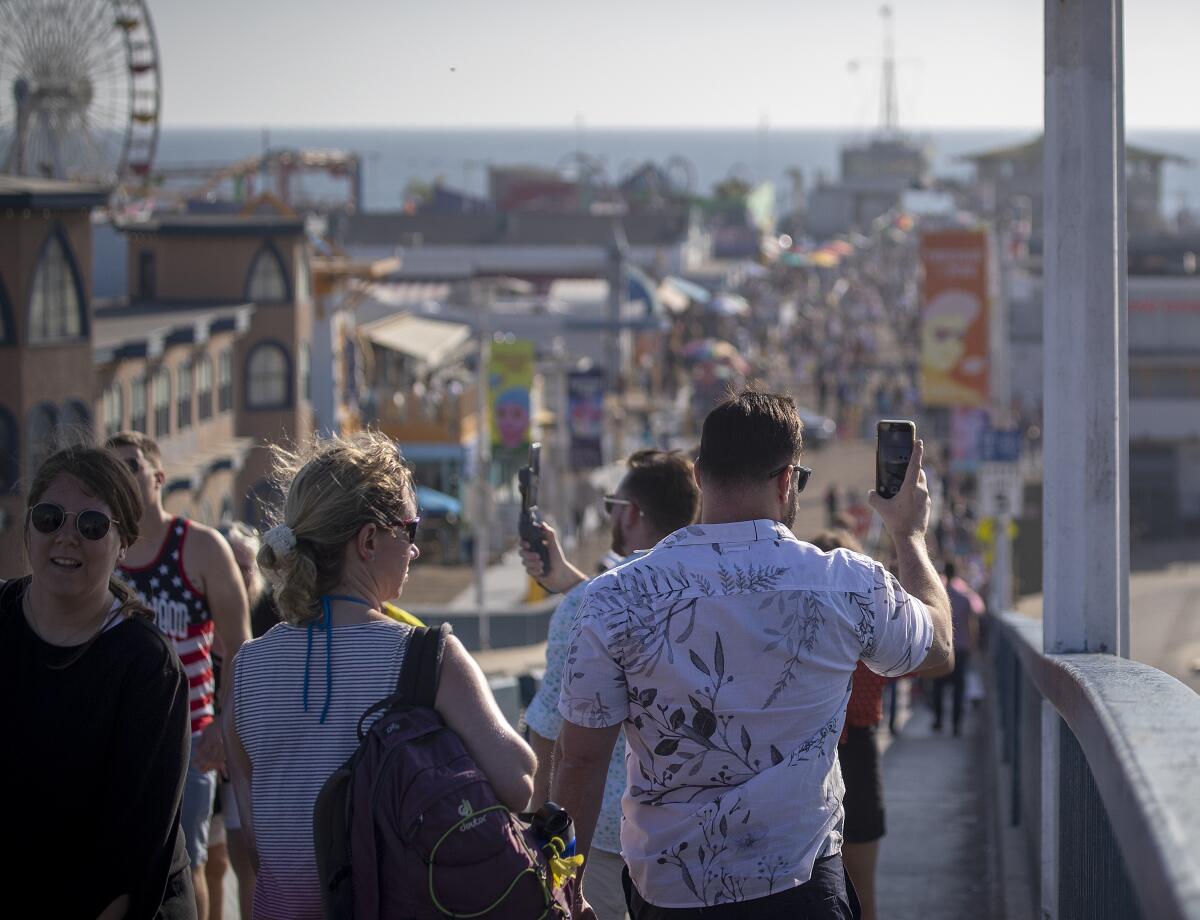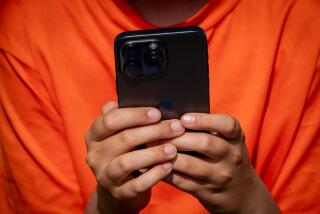We know phones are bad for us. Now, ‘digital detox’ is a business model

- Share via
How often do you look at your phone each day, checking Twitter, Instagram, Slack or whatever emails might have come in over the last five minutes?
More than you might realize.
A 2018 Deloitte survey showed Americans look at their phone 52 times a day on average. Tech insurance and support company Asurion’s 2018 survey pegged it at 80 times a day. “Tech neck” is approaching public health crisis levels. If you’ve ever ignored your partner to look at your phone, you’ve taken part in a behavior known as “phubbing,” a term coined in 2012.
We love our phones. A lot. Is it an addiction? Experts disagree.
Wendy Wood has an entire chapter of her forthcoming book “Good Habits, Bad Habits” titled “How To Stop Looking at Your Phone So Often.” Wood, a provost professor of psychology and business at USC who studies habits, says phone usage — while pervasive — doesn’t rise to the level of being an addiction for most people.
“Addiction is characterized by an inability to stop using a drug, in this case a phone; failure to meet work, social or familial obligations; and sometimes, depending on the drug, tolerance and withdrawal,” Wood said. For most people, that’s not the case — “which doesn’t mean there aren’t some people who fit that requirement,” she said. “For most people, phone use is more of a habit that we haven’t quite figured out how to control.”
But some think phone usage does qualify as an addiction, particularly among younger people. Digital sociologist and USC lecturer Julie Albright is the author of the book “Left to Their Own Devices: How Digital Natives Are Reshaping the American Dream,” which explores the impact devices have had on young people’s real-life connections.
“I didn’t used to use the word ‘addiction.’ I didn’t like the word ‘addiction,’ ” she said. But at this point, she feels it fits, particularly for Gen Z, the oldest of which are finishing college now. A sorority house mother on campus mentioned to her that the girls seemed to have lost the art of conversation, that they speak briefly to one another at group dinners but all quickly gravitate back to their phones. She said the dean of religious life at USC told her he gets a question from a student at least once a week now that he never received five years ago: “How do I make friends?”
In some ways, phones broke us. As we’ve used the language of addiction to describe how we use them, so too has that vocabulary extended to fixing the problem: Worldwide Google searches for “digital detox” have been rising steadily over the last five years. At the same time, rates of depression, anxiety and other mental health issues among teens and young adults — the group that collectively spends the most time on their phones — have spiked.
But in any case, a world of coaches, books, podcasts, wellness programs, camps and retreats have sprung up to help those of us who need a little external assistance to guide our “digital detox.”
As with so many problems in our lives, the cause can also facilitate the solution. Andy Petranek is co-founder of the Whole Life Challenge, a six-week online game in which you compete against your friends, family and other players to try to develop better habits in areas like nutrition, exercise, sleep and well-being. Twenty-eight thousand people participated in the January challenge this year. Enrollment costs between $29 and $59, depending on how far in advance you sign up; registration for the next challenge, which launches Sept. 28, extends through Oct. 9 for latecomers.
Petranek opened a CrossFit gym in L.A. in 2004; he started the Whole Life Challenge as a way to incorporate overall wellness into his clients’ lives. (Michael Stanwick, who was the general manager of his gym at the time, is the co-founder.) For the nutrition aspect, there’s a list of permitted foods; to get your points in exercise, be active for 10 minutes a day. The well-being piece is a little more ambiguous. Every week, a new well-being practice is announced. Sometimes, Petranek said, it’s decluttering or meditation. Other times, it’s related to digital detox: No phones during meals for a week. Turn off phone notifications for a week. Move social media apps off your home screen for a week.
One was “no social media for a week,” which “generated a very strong, interesting response” among participants, Petranek said: “People responded to that as if we told them they could no longer communicate with their grandchildren.”
If you need one-on-one help, you could find someone like Laurin Seiden, a life coach based in L.A. (laurinseiden.com) who’s been coaching since 2007. In 2014, she started hearing complaints from clients about phones and social media. Over time, she said, it seems as if feeling tethered to phones and social media has gone from being something people are concerned about to something people just live with as a fact of daily life.

“Now, it’s just the norm. It’s almost like we’ve been numbed to the noise,” she said.
She tries to get clients to tease out their goals and values: what they really want out of their lives versus what they’re doing to achieve it. Frequently, she said, that involves a hard conversation about phone time. Seiden charges $500 to $700 per session or $375 a session in packages of 10.
Some people might just need a reset from their phones. Enter Camp No Counselors (campnocounselors.com), a 21-and-over weekend camp where phones aren’t welcome. Dave Kushner, director and “head camper,” said Camp No Counselors started in 2013 as a big trip for a group of friends. The idea: Wouldn’t it be awesome if we rented some old campgrounds for a week and relived summer camp? They inadvertently picked a place with no cell service. At the end, they realized being forcibly removed from their phones felt rewarding, not punishing. When they expanded into a company, they made it one of the core tenets that phones had to stay behind in the bunks.
“People say often it’s the best part of the weekend, because you’re allowed to get yourself off that leash,” Kushner said. “Sometimes you feel phantom signals from your pocket for the first day or so. But it’s so nice to just be able to escape again. It’s a luxury in this time to be able to escape a lot of the stresses of the real world. People love to drop that for just a weekend.”
The average ticket price is $500- to $600. Prices start at $550, which includes four days of lodging, food, late-night snacks, and classic camp activities like archery, dodgeball, arts and crafts, hiking, friendship bracelet weaving and water slides. Also, a not-so-classic activity: an open bar. A paid photographer captures the activities to further reduce phone temptation. Camps are run in Valencia and in Wayne County, Pa., and Kushner says the company is looking to expand to more cities in 2020.
If you’d rather not cough up hard cash to look at your phone less, there are a few tips to help get you started. Put your phone away during meals. Practice intention when you use your phone: Before you go to pick it up, ask yourself why. Are you bored? Uncomfortable? In an awkward social situation? Sit with that for a minute and decide whether you have a good reason to be looking or if it’s just a reflexive motion.
If it’s just a reflexive motion: Put it down. That’s free.
More to Read
Sign up for The Wild
We’ll help you find the best places to hike, bike and run, as well as the perfect silent spots for meditation and yoga.
You may occasionally receive promotional content from the Los Angeles Times.











